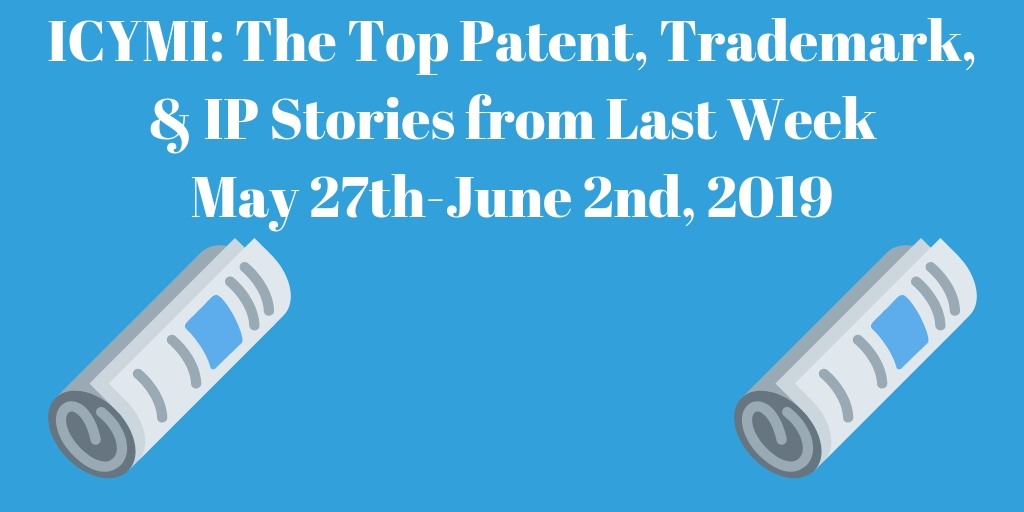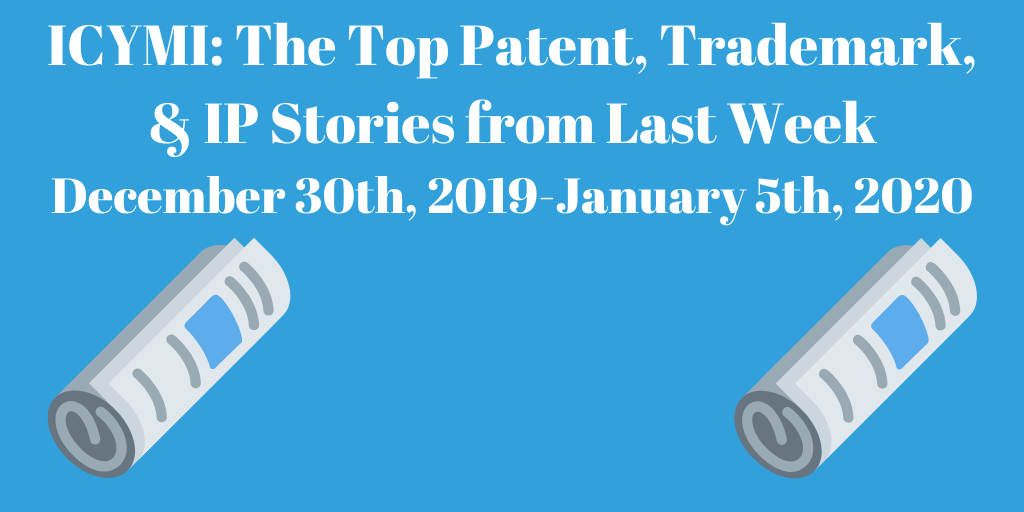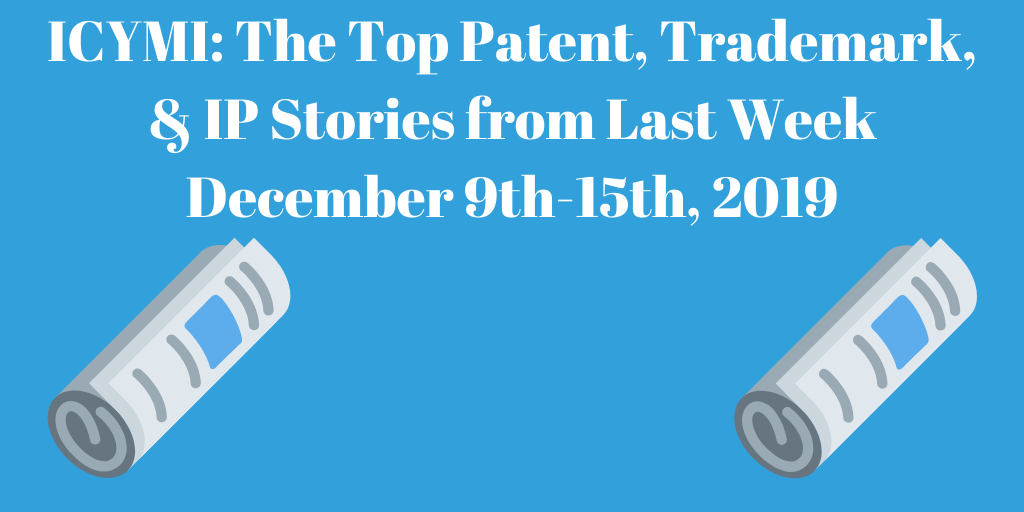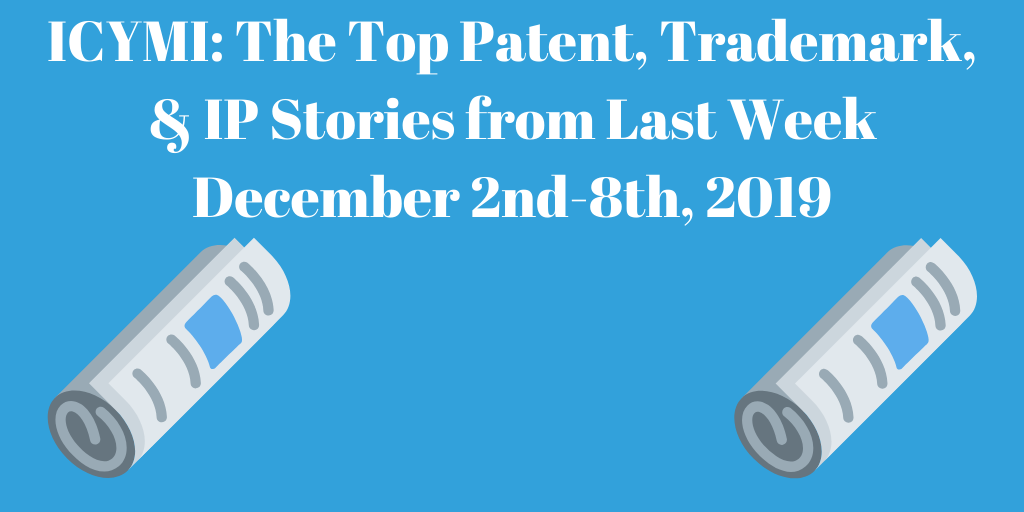Top Patent, Trademark, and IP Stories from Last Week (5/27-6/2/19)
Every week, we will be highlighting the top patent, copyright, trademark, intellectual property, etc. stories of the previous week in our “In Case You Missed It” segment. The list itself is in no particular order and includes a wide range of stories from the patent world that are informative, noteworthy, or just plain bizarre. The stories included encompass everything from Supreme Court cases to insights into growing industries. Please feel free to comment your thoughts on the stories or share an important one we missed!
“Settlement of Suit Over Tom Brady Photo Leaves Major Online Copyright Issue Unresolved”
Back in 2016, Justin Goldman snapped a picture of New England Patriots quarterback Tom Brady seen together with Boston Celtics general manager Danny Ainge in New York. Goldman, who is not a professional photographer, shared the photo to his snapchat story at which point the photo went viral, spreading to Reddit, Twitter, and the like. From there, the photo was featured in articles by way of embedding tweets containing the photo.
In 2017, Goldman filed a copyright infringement suit in U.S. District Court against media companies including Breitbart, Vox Media, Time, Yahoo, and others for using the image without his permission. The media companies, who banded together against the suit, argued they did not infringe Goldman’s copyright given the photograph was not hosted on their sites but rather embedded via Twitter.
In 2018, a federal district court judge sided with Goldman, ruling that embedding the image from another site does not “shield” media companies from liability. Embedding an image from another site still violates Goldman’s “exclusive display right.” That is when the media companies filed an appeal, which was denied. Most of the defendants settled and the case was voluntarily dismissed last week before reaching another district court ruling.
Given a lot of news is broken over Twitter, the ambiguous outcome of this case presents a huge question mark for publishers when it comes to the embedding of relevant news items. With plenty of similar cases ready to be heard in district court soon, media companies should be ready for a possible industry shakeup as courts crack down on embedding copyrighted material. To read more about this story, click here (via Forbes, May 29th, 2019).
“Apple Patents Foldable Screen Tech That Bends Multiple Ways”
Last week Apple was granted the patent for a “foldable cover and display for an electronic device.” The win comes at a time when numerous other smartphone makers are bringing foldable phones to the market. These include Samsung with its “Galaxy Fold” phone and Huawei with its “Mate X” model. The patent does not indicate whether the technology will be limited to simply the iPhone or iPad alone but rather any “electronic device.”

In the patent, the electronic device is seen being capable of folding and unfolding into a device with at least double the screen size. Apple indicates the screen size can also be adaptable writing “the electronic device can be partially or wholly unfolded to adjust the size of the viewable display area.” Such technology applied to an iPhone for example would make an iPhone able to become a mini iPhone tablet or iPad of sorts.
Although Apple has yet to confirm whether it will go ahead with the technology, do not be surprised if it jumps on the bandwagon given the hype of the Galaxy Fold. To read more about this article, click here (via CNET, May 29th, 2019).
“Of Supply Chains and Fireworks: A Trade War With China Is Easy to Lose”
The current U.S.-China trade war continues to rage on as the two countries wrestle over accusations of IP theft. Such theft has hurt both small time inventors and big conglomerates alike. In his piece for IPWatchdog, former Deputy Director of the World Intellectual Property Organization James Pooley lays out the trade war and offers his solutions to the strife. Pooley notes that a country’s investment in the establishment of a strong IP system, and its enforcement, correlates with the development of innovation in that country, China being a prime example.
He notes that as China’s economy has exploded over the past 30 years, it has also become one of the most respected patent systems globally. Despite this, China has been rightly accused of IP theft by the U.S. who estimates an annual loss to China over such theft at “between $225 billion and $600 billion.” As a result, the Trump administration recently instituted bans on Huawei products (a company synonymous with IP theft) and raised tariffs to stop such theft. With the threat of a retaliatory rare earth ban by China looming (of which China holds 90% of the world’s supply) there could be huge implications for U.S. manufacturers.
Pooley argues the countries must create new agreements including tougher enforcement of IP rights as well as developing measures to prevent espionage such as more secure encryption methods. The countries should work together on protecting IP rights and reach an agreement to promote innovation. To read more about this story, click here (via IPWatchdog, May 30th, 2019).
“US Patent and Trademark Office Approves Two NBA Logos, but Denies Another”
The USPTO has once again denied the trademark registration for the San Antonio Spurs’ alternate logo, doing so last week after a failed 2017 attempt. The office indicated the logo was not unique, stating that “arranging the initials of a professional basketball team within a basketball” is an “obvious, almost inevitable configuration that does not demonstrate sufficient creativity.”

In addition, the office felt the basketball shape and “minimal” color scheme of black and grey, the team’s colors, did not add “sufficient creativity to the design.” To read more about this story, click here (via World IP Review, May 31st, 2019)




